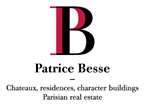An impressive 18th century chateau on almost 5 ha of land in the Bresse region of Burgundy, to be saved - ref 464626
An impressive 18th century chateau on almost 5 ha of land in the Bresse region of Burgundy, to be saved.
Not far from the motorway connecting the regional capitals, it takes 1h30 to drive to Lyon and 1h to Dijon. Geneva is 2 hours away. The property can also be reached in 30 minutes from Chalons-sur-Saône, Beaune or Louhans. The nearest shops are located 4 km from the village. The Bresse region of Burgundy includes plains and woodlands crossed by rivers and lakes, punctuated by a sparse rural habitat built of wood, brick or stone.
The chateau is situated on the outskirts of a village of some 200 inhabitants, on the site of an earlier fortified house. It used to face two outbuildings, one of which still exists, all surrounding a vast square courtyard, bordered by an old moat, part of which has been restored. All the buildings face east/west.
The chateauCertainly rebuilt during the second half of the 18th century, it follows the stylistic rules of its time. Entirely of brick with a stone foundation, it has a central section flanked by two symmetrical, slightly projecting wings. Between the ground and the first floor runs a stone stringcourse. Each of the three sections is topped by an imposing roof structure clad with flat tiles. There are seven triangular pediment dormers on the eastern side.
Probably abandoned after the French Revolution, it was used as a farmhouse until the end of the 20th century. Because of the tax on doors and windows in force until 1926, the openings on the unused first floor were filled in with brick and those on the ground floor were reduced in size.
The ground floor
This is accessed via a main doorway in the centre of the building, framed in dressed stone with an arched lintel, topped by a projecting voussoir. With a brick stringcourse at mid-height, this level has retained its original openings on the east facade, while they have been reduced in size on the western facade. It was inhabited, partitioned, and heavily altered during the 20th century, when modern materials were also employed. The building is dilapidated and unfit for habitation in its current state, and it would seem advisable to recreate the original, perfectly intelligible volumes.
The first floor
This is the piano nobile of the building. It is accessed in the centre of the building by a striking dogleg oak staircase with newel pendant and turned wooden balusters. This floor, although it has lost most of its original decorative elements, has remained in a rather untouched original state, without excessive modernisation. A corridor on the eastern side provides access to two large dual-aspect rooms of more than 55m², located in the central part of the building, on either side of the staircase. Two extensive rooms of more than 70 m² follow; they are located in the slightly protruding wings. All of these rooms have preserved beamed ceilings, some with traces of painted friezes, plaster fireplace overmantels and oak doors.
The attic
The main staircase rises up to the top floor. It provides access to a stunning three-volume roof structure, the height of which would allow for conversion into a living space. The chimney stacks and the flat-tile roofing would require imminent work. The outbuildingRecorded on the Napoleonic cadastral map at this location, it was rebuilt during the 20th century for agricultural use, of coursed rubble masonry and fibre cement sheets. Another Bresse style agricultural outbuilding stood next to the first one until a few years ago. The groundsA former courtyard surrounded by a moat protecting the chateau and its outbuildings, mentioned at the beginning of the 19th century, can still be clearly made out. The ...

